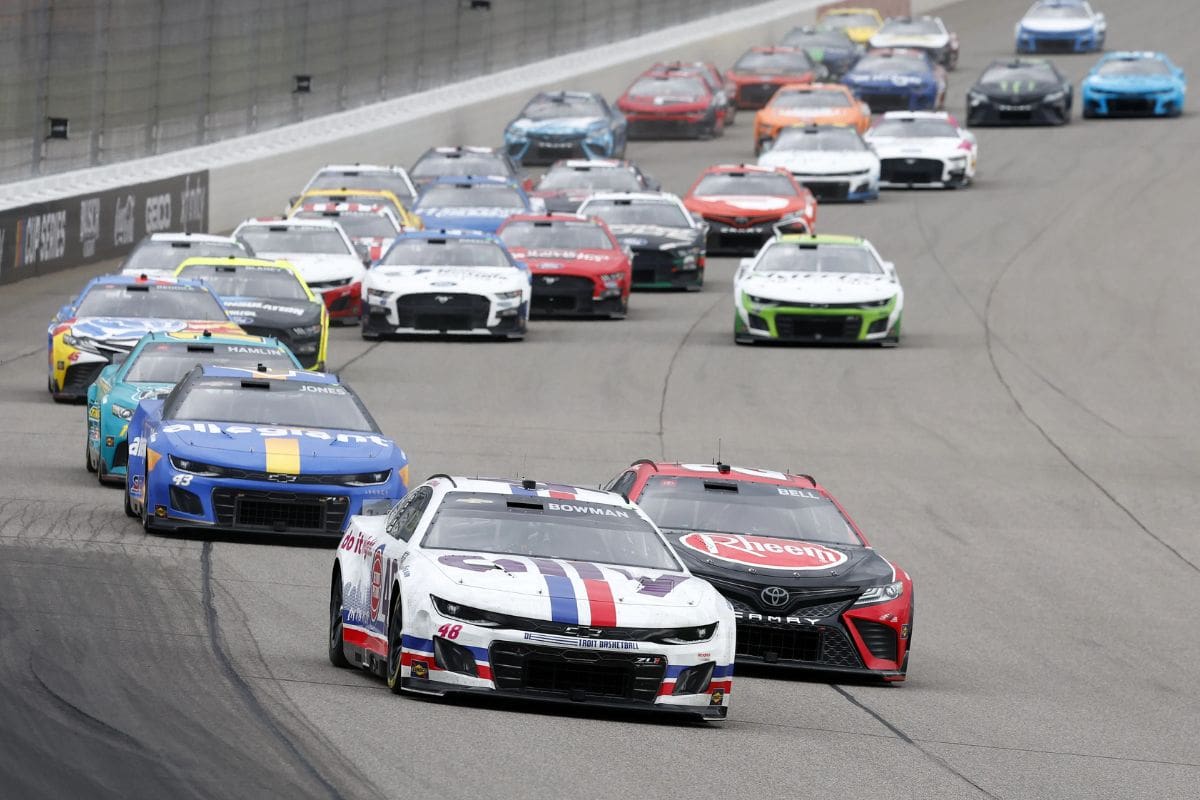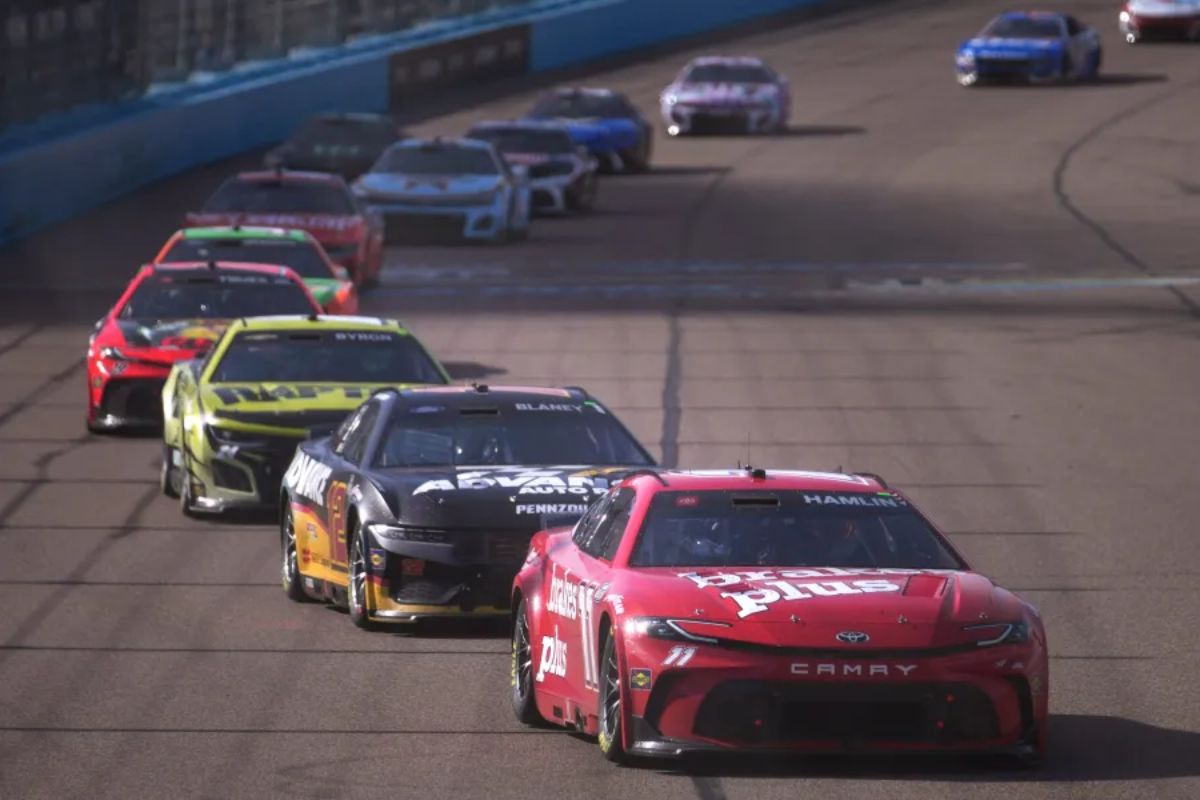Ty Gibbs’ Reagan-Themed Car: Ty Gibbs‘ introduction of a Reagan-themed car into the NASCAR circuit has ignited a contentious dialogue among fans, highlighting the delicate balance between personal expression and the sport’s traditional values. This striking design, characterized by its vibrant colors and political imagery, not only challenges the conventional aesthetics of racing but also raises critical questions about how far the sport can intertwine with political themes. As opinions split between those who admire the tribute and those who see it as a potential distraction, the implications for NASCAR’s identity and fan engagement become increasingly complex. What does this mean for the future of the sport?
Key Highlights
- Ty Gibbs’ Reagan-themed livery features patriotic colors and imagery, aiming to evoke nostalgia and celebrate American heritage in NASCAR.
- Fan reactions are mixed, with some praising the bold design while others criticize it for overshadowing the car’s racing essence.
- The livery sparks a broader conversation about the intersection of politics and sports, raising questions about appropriateness in NASCAR’s diverse community.
- Supporters see the design as a creative departure from tradition, while critics prefer more subtle branding that aligns with NASCAR’s visual norms.
- This unique marketing strategy targets specific demographics, potentially influencing future designs and themes in NASCAR branding.
Introduction to the New Livery
Joe Gibbs Racing has revealed an intriguing new livery for Ty Gibbs’ car, celebrating a notable figure from American history. This bold choice, rooted in the team’s desire to innovate while honoring historical legacies, has sparked a polarized reaction among fans and commentators similarly.
The tactical decision to incorporate such a substantial motif serves as a reminder of the complex interplay between sports and cultural narratives, positioning NASCAR not just as a racing circuit but also as a platform for broader dialogue.
In the world of motorsports, particularly in NASCAR, the aesthetics of a car can evoke strong emotional responses, often leading to fan division. A custom paint scheme can either herald a new era of creativity or clash with traditional expectations.
When Joe Gibbs Racing opted for this unique livery, they ventured into territory where opinions are often sharply divided—an outcome that is, in many ways, a hallmark of contemporary fandom.
This duality of response—love it or hate it—reflects deeper affiliations and sentiments tied to the featured historical figure, in addition to the constantly changing nature of NASCAR’s audience.
The introduction of this new livery not only aims to captivate viewers but also to ignite discussions around the confluence of history and modern racing culture.
As fans prepare for the upcoming Daytona race, the anticipation surrounding Ty Gibbs’ car serves as a microcosm of the ongoing dialogue in sports about identity, legacy, and the boundaries of creativity.
Details of the Reagan-Themed Livery
The revealing of Ty Gibbs’ Reagan-themed livery represents a striking blend of patriotism and nostalgia, embodying the fervor surrounding the upcoming film. Set to race at the Coke Zero Sugar 400, just five days before the movie’s premiere, Gibbs’ No. 54 car displays a design that is both audacious and representative of American identity. The entire vehicle is draped in the colors of the United States flag, offering a visually arresting sight that immediately captures attention on the racetrack.
Prominently featured on the door panels and hood are images of former President Ronald Reagan, further intertwining the domains of motorsports and political heritage. This choice of imagery reflects a tactical marketing initiative that aligns Gibbs’ racing persona with a figure celebrated by many for his conservative values and leadership during a crucial era in American history. The livery not only aims to promote the film but also to resonate with a demographic that admires Reagan’s legacy.
Here's the @ReaganMovie paint scheme for Daytona, promoting the forthcoming Dennis Quaid film about Ronald Reagan on JGR's No. 54 Toyota. pic.twitter.com/EUwbJN256A
— Adam Stern (@A_S12) August 20, 2024
However, the design’s boldness is not merely aesthetic. It evokes a sense of pride and historical reflection that resonates with many fans, while potentially alienating others who may view it as overly nationalistic or out of place in the sport.
As excitement builds for the movie’s release, the livery stands as a conversation starter, inviting discourse around the intersection of entertainment, politics, and American culture. Gibbs’ car, consequently, becomes more than just a racing machine; it embodies a cultural statement poised to ignite varied reactions among the NASCAR community.
Mixed Reactions from Fans
Frequently, fans find themselves grappling with their emotions as they respond to Ty Gibbs‘ Reagan-themed livery on his No. 54 car. The design, a bold homage to the former president, evokes a spectrum of reactions that reflect both admiration and confusion. One fan’s comment—“This car is all over the place. I can’t tell if I like it or hate it”—encapsulates the dissonance many experience when encountering this striking vehicle.
On one hand, the livery’s audacious aesthetics demand attention; its vibrant colors and intricate details serve as a visual celebration of Reagan’s legacy. This boldness may resonate with fans who appreciate the risk-taking approach to design in a sport often characterized by traditionalism. The car stands out on the track, certainly leaving a lasting impression.
“That’s hot; I like it a lot.” – fans’ reaction
Conversely, the overwhelming elements of the design can be perceived as excessive, leading to viewer fatigue. Critics argue that the tribute, while well-intentioned, may detract from the essence of racing, where simplicity often reigns supreme. The contrast of a political figure’s imagery against the backdrop of high-speed competition raises questions about the appropriateness of such themes in a sport that thrives on diverse fan engagement.
Positive and Enthusiastic Reactions
Many fans are embracing Ty Gibbs’ Reagan-themed livery with palpable excitement, viewing it as a revitalizing departure from the conventional designs often seen in NASCAR. The car’s patriotic colors and striking visuals resonate deeply, eliciting enthusiasm that emphasizes a yearning for boldness in the sport.
One enthusiastic fan succinctly captures this sentiment, stating, “That’s hot; I like it a lot.” Such reactions highlight a growing appreciation for creativity and thematic representations within racing aesthetics, suggesting that fans are keen for fresh narratives that transcend traditional motifs.
The design’s connection to national pride and historical significance is a compelling aspect that many find appealing. Another fan expressed surprise and delight, remarking, “It looks good; I’m quite surprised that Ty got sponsored by a movie.” This reaction reflects a blend of admiration for the livery’s aesthetic and intrigue regarding its sponsorship—elements that intertwine to create a unique conversation around the car.
The Reagan-themed design, featuring colors reminiscent of the national flag, not only stirs patriotic feelings but also invites discussions about the intersection of popular culture and motorsport.
In this context, Gibbs’ car emerges as a bold statement, one that challenges the status quo and encourages fans to reflect on the broader implications of aesthetics in NASCAR. As reactions continue to unfold, it is clear that many supporters welcome this creative approach, viewing it as an opportunity to infuse personality and passion into the racing experience.
Criticisms and Concerns
While enthusiasm surrounds Ty Gibbs’ Reagan-themed livery, it has not escaped scrutiny, as some fans voice concerns about its bold design choices. Critics argue that the car’s photorealism scheme lacks the refinement typically associated with NASCAR designs, leading to a divide among fans. The glaring contrasts of the livery have prompted a variety of opinions that highlight an ongoing tension between creativity and tradition in racing aesthetics.
“Logos and colors are the only thing that work on these cars. These photorealism schemes are always hideous.” – fans’ reaction
Several key criticisms have emerged regarding the livery:
- Over-the-Top Design: Many fans feel the design is excessively bold, overshadowing the car’s purpose and competing with established visual norms in NASCAR.
- Photorealism Flaws: Detractors point out that photorealistic elements often result in a “hideous” appearance, diluting the effectiveness of the branding on the car.
- Preference for Subtlety: Some fans argue that traditional logos and color schemes have a timeless appeal, advocating for a more understated approach to car design.
These concerns reflect a broader debate within the NASCAR community about the balance between innovation and heritage.
While some keenly anticipate the car’s debut under the lights—believing the design may shine brighter in motion—others remain skeptical, yearning for a return to simpler, more cohesive designs.
As Gibbs prepares to reveal the livery on the track, the conversation surrounding its impact on the sport continues to evolve, revealing the diverse perspectives that characterize NASCAR fandom.
News in Brief: Ty Gibbs’ Reagan-Themed Car
The introduction of Ty Gibbs’ Reagan-themed car has undeniably stirred a considerable discourse within the NASCAR community. This bold design, while celebrated for its vibrant aesthetics and patriotic connotations, also raises pertinent questions regarding the intersection of sports and political identity. The divided reactions highlight the complexities of a diverse fanbase and the ongoing dialogue about tradition versus innovation in racing. Ultimately, this livery serves as a microcosm of broader societal trends, reflecting both pride and disagreement in contemporary culture.
ALSO READ: toyota-engine-failures-threaten-ty-gibbs-playoff/”>Toyota Engine Failures Threaten Ty Gibbs’ Playoff Dreams: Can He Survive the Season?



